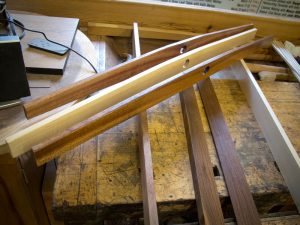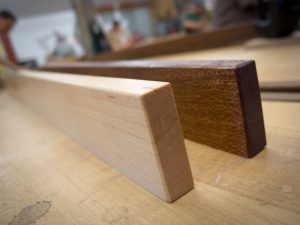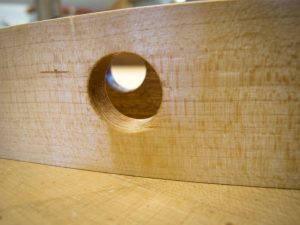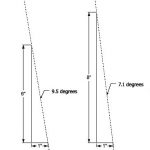We may receive a commission when you use our affiliate links. However, this does not impact our recommendations.
When it comes to making wooden shop tools, I think that most of the modifications we make to them are to stop us from throwing the tools away by accident.
Many winding sticks are a right triangle in profile. Why? Mostly (I think) to prevent you from pitching them out with the garbage. Yes, the wider base makes them more stable, but not significantly so.
But when it comes to wooden straightedges, there are some other theories.
They go like this:
1. You make the top edge of the straightedge taper to its ends. This does three things: It means your straightedge will have only one “straight edge.” That’s a good thing because you have only one edge to maintain and won’t get two edges confused. And, the theory goes, it allows the straightedge to respond more rapidly to changes in humidity.
Wood loses and gains most of its moisture content through the end grain. So by exposing more of the end grain along the straightedge, the middle section is more likely to change in width at the simultaneously as the ends. With a straightedge with parallel edges, the ends will shrink and swell before the middle gets the moisture message.
And the bevels make you less likely to throw the straightedge in the burn pile.
2. You bore a hole or oval in the middle of the straightedge. This does three things: It makes the straightedge easier to carry around. It exposes more of the end grain in the middle of the tool to the atmosphere (see No. 1 above). And it makes you less likely to transform it into a sword for your 5-year-old Conan the Barbarian.
3. You lightly chamfer the long bevels and the rim of the hole. You add a finish. These details help prevent you from using the stick as a nine iron to drive your squirrel population into the neighboring county.
The big question for most woodworkers is about the moisture exchange. Do those construction details really help the straightedge stay true? I’ve made many straightedges using the above techniques and they seems to stay fairly straight. But what makes me think there is some evidence to support the idea is my winding sticks. They have parallel long edges. They have to, or they don’t work.
Right now, both my winding sticks are 5 thou fatter at the ends than at the middle. And I’ve been in Deep South humidity with them this summer.
So I think these construction details are worth incorporating into your straightedge – if only to keep you from using the tool to skewer an entire brisket and run down the street yelling “Beef parade!”
— Christopher Schwarz
Need a place to put your straightedge? Build a traditional tool chest in only two days using home center materials and tools. Details on the DVD here at ShopWoodworking.com.
Here are some supplies and tools we find essential in our everyday work around the shop. We may receive a commission from sales referred by our links; however, we have carefully selected these products for their usefulness and quality.













All this talk about tallow,where can I get some?
I bought an eight-foot length of Aluminum angle for a shop project (that’s the minimum length) and am using two (leftover) lengths as winding sticks / straight edges. They can be drilled to hang out of the way and the likelihood of them getting into the burn pile is very low.
On straightedges, one edge is curved simply so you’ll know which is the trued edge and which is not. Painting them lime green will also prevent (or maybe not) their being thrown out. I’m thinking the curve plus hang-hole should be sufficient.
Winding sticks are tapered to the top so they will be a little bottom-heavy and therefore more stable when sitting atop whatever is being tested. The taper is also an optical aid, it seems to make the edge sharper to the eye and the test more sensitive.
The whole bit about shaping to equalize moisture exchange and so forth is mostly tedious bunk.
Winding sticks and straight edges should be placed in a bath of linseed oil in an old piece of guttering for two weeks after they’re made in order to drink up every drop they could possibly absorb. Use them for a while and then do the whole process again, maybe six months later. Check them for true before the 2nd oil treatment, nip and tuck as needed.
Chris said
“the middle section is more likely to change in width at the simultaneously as the ends”
Possibly I just need a rare 3rd cup of Joe this morning, but I can`t get around this statement. Are there words missing? Possible lapses in sobriety? Splain it to me Lucy!
I also want to bear witness to you striking a living squirrel with a stick, no not a PETA matter, just thinking you can`t do it.
Your observation does not provide evidence in support of your conclusion. You have observed that winding sticks subjected to the injustice of Georgia weather appear to absorb more moisture through their ends than through their faces/edges. But we already knew that.
What you haven’t shown is whether the various modifications to straightedges provide enough compensation to make any practical difference. You’d have to take your hole- or taper-equipped straightedges to Georgia to do that.
-Steve
I have always assumed the triangular shape of a winding stick made it easier to see the edge clearly. A wide edge is more difficult to view clearly as you raise and lower your sight line to see both sticks.
Yes indeed coat end grain. I turn mallets from greenwood centered on the pith! Outrageous? Not if I coat ALL END GRAIN. Also wooden screws. I use tallow. Nothing splits. The price is right. The tallow soaks in and the surfac is not greasy. Please let me know of any problems with this. Of course no tallow if the surface is to be finished.
I don’t know how YOU were raised Chris, but where I come from a nine iron is much too light for a squirrel. Anything lighter than a seven iron, and your just wasting time. Voles on the other hand…
Beef Parade!!!